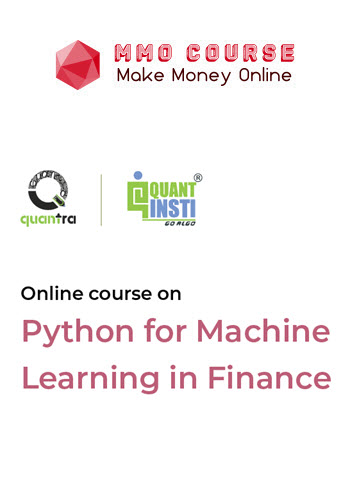Quantra – Python for Machine Learning in Finance
$179.00 $72.00
Delivery: Instant Delivery
Description
Quantra – Python for Machine Learning in Finance
Python for Machine Learning in Finance is perfect for those looking to get started on using Python for Machine learning. Learn in a step-by-step fashion to create a Machine Learning algorithm for trading. Evaluate the performance of the machine learning algorithm and perform backtest, paper trading and live trading with Quantra’s integrated learning.
- Backtest, analyse the strategy returns and drawdowns, paper trade and live trade machine learning strategy
- Describe machine learning and its applications in finance
- List and implement common tasks in machine learning such as feature creation, training, forecasting, and evaluation in a step-by-step fashion
- Explain and implement accuracy, f1-score, recall and confusion matrix and R-squared
- Implement the train-test split for time series data
What You’ll Learn In Python for Machine Learning in Finance
Introduction
Machine learning has myriad applications in various industries, including finance. In this section, you will acquaint yourself with the course structure, and the various teaching tools used in the course: videos, quizzes, and strategy codes. The interactive methods used help you to not only understand the concepts, but also how to implement the strategies.
Machine Learning Overview
In this section, you will understand how machine learning is used to solve problems which cannot be solved by traditional computer algorithms. You will also see its applications in different finance domains.
Introduction to Python
This section will help you update your knowledge of Python with simple exercises on implementing functions, and manipulating dataframes using Numpy and Pandas libraries. The Quantra environment ensures that you don’t have to install anything for the Jupyter notebooks to function.
Financial Market Data and Visualisation
An important component of a successful strategy is the data set used. In this section, you will learn how to import the correct data from various web resources, so that you can work on your own unique strategy.
Machine Learning Tasks
Before you start using the machine learning model, you have to train it first. In this section, you will go through the steps in creating a machine learning algorithm and how its performance can be calculated.
Target Variable and Features
A target variable is something that a machine learning algorithm tries to predict. And in order to do that, it requires input, which are called features. This section will explain the concept of target and features through examples. You will also learn how to create target and features for an ML algorithm.
Machine Learning Algorithms
There are various types of machine learning algorithms. In this section, you will get an overview of each type of algorithm. You will also gain a basic understanding of which model to use for a particular problem statement.
Train-Test Split
The train-test split is the technique of splitting the data into two parts. One part is used to train the ML model, and the other part is used to evaluate how well the model is making the predictions. You will learn the correct way of dividing time-series data for the train-test split.
Training & Forecasting
The model is trained on the training data and then it is used to make forecasts. In this section, you will learn how to use the training and testing data with a machine learning model. For illustration, we implement a Random Forest classification model in Python and use it to make predictions.
Metrics to Evaluate Classifier
Backtesting is used to separate good strategies from bad ones. In this section, you will learn how to analyse the performance of your strategy on the historical data through backtesting. You will also learn to develop and backtest a trading strategy in Python. You will further calculate certain metrics like strategy returns, annualised returns and Sharpe ratio.
Introduction to Backtesting
Backtesting is used to separate good strategies from bad ones. In this section, you will learn how to analyse the performance of your strategy on the historical data through backtesting.
Live Trading on Blueshift
This section will walk you through the steps involved in taking your trading strategy live. You will learn about backtesting and live trading platform, Blueshift. You will learn about code structure, various functions used to create a strategy and finally, paper or live trade on Blueshift.
Live Trading Template
This section includes a template of a trading strategy that can be used on Blueshift. The live trading strategy template is based on the strategy discussed in the course. You can tweak the code by changing securities or the strategy parameters. You can also analyse the strategy performance in more detail.
Metrics to Evaluate a Regressor
Along with the classifier model, you can also use the regression model to predict the target variables. In this section, you will be given a brief on linear regression and also how to analyse its performance by using the goodness of fit metric.
Run Codes Locally on Your Machine
Learn to install the Python environment in your local machine.
Course Summary
In this section, you will go through the different concepts you learnt throughout the course. You will also be able to download all the strategy notebooks as a zip file. You can use these notebooks and modify their contents to create your own unique strategy.
Delivery Policy
When will I receive my course?
You will receive a link to download your course immediately or within 1 to 21 days. It depends on the product you buy, so please read the short description of the product carefully before making a purchase.
How is my course delivered?
We share courses through Google Drive, so once your order is complete, you'll receive an invitation to view the course in your email.
To avoid any delay in delivery, please provide a Google mail and enter your email address correctly in the Checkout Page.
In case you submit a wrong email address, please contact us to resend the course to the correct email.
How do I check status of my order?
Please log in to MMOCourse account then go to Order Page. You will find all your orders includes number, date, status and total price.
If the status is Processing: Your course is being uploaded. Please be patient and wait for us to complete your order. If your order has multiple courses and one of them has not been updated with the download link, the status of the order is also Processing.
If the status is Completed: Your course is ready for immediate download. Click "VIEW" to view details and download the course.
Where can I find my course?
Once your order is complete, a link to download the course will automatically be sent to your email.
You can also get the download link by logging into your mmocourse.hk account then going to Downloads Page.
Related products
Total sold: 5
Total sold: 1
Total sold: 4










